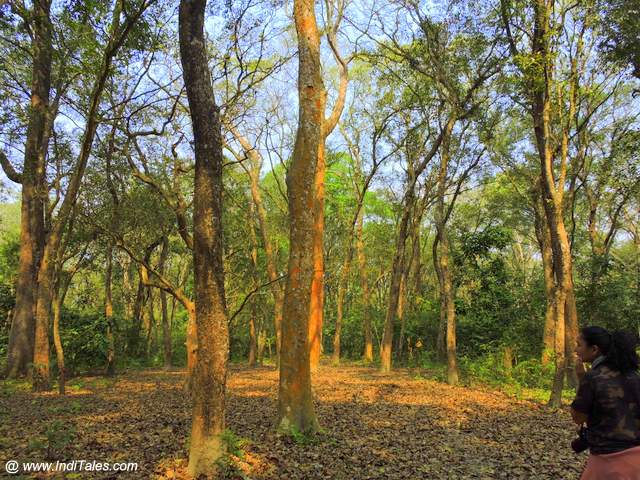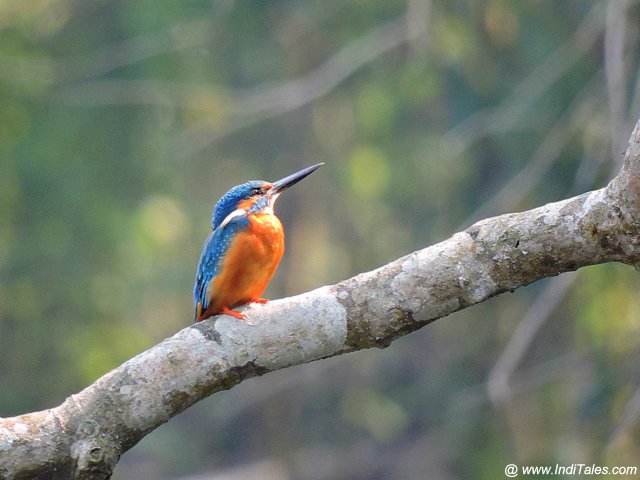We woke up early to the sounds of Chitwan National Park surrounding us. We stepped into the boat to cross the Rapti River next to our Barahi Jungle Lodge for a Walking Safari at Chitwan. The river was still drenched in the mist that was slowly rising from the river like smoke. Everything looks mystical through this mist. Our boat moved slowly towards the other bank of Rapti. Some other boats joined us on the river. Suddenly all of us stopped to let the Rhino cross the river first.

When our boatman parked the boat very close to the point where Rhinos had just entered, we had second thoughts about leaving the boat. However, our guides gave us confidence and we stepped into the forest.
Walking Safari At Chitwan National Park
Well, we were on a walking safari. After exploring the jungle from the safety of a Jeep and a boat, today we were planning to walk through the jungle.

Rhino’s entry into the same part of the jungle made us curiously nervous. However, we were constantly reminded that there are more than 600 Rhinos at Chitwan National Park. They are all around whether we see them or not. We were also told that Rhinos are not really interested in humans unless they sense danger from us. I wondered how would they know I am scared of them and they have no reason to be scared of me when all they can see is that I am from a species that is known for killing them.
The beauty of Nature at Chitwan
As we started walking, the fear started subsiding. My eyes started taking in the beauty all around me. Small ponds reflected the tall trees around them as the mist slowly lifted from them. It was like a pond revealing itself in slow motion.

We were walking on the bed of dried leaves that created a rustle every time we took steps – I wondered if Rhinos and their other wild friends could hear this and react. It was a lovely scene – a bed of sepia-dried leaves and tall green trees emerging out of them. In places, trees form a canopy as if they are leading you to a special place.

Our walk leader Saket kept pointing out the small creatures. I frowned, how is it that he is able to see all these and I have to strain my eyes before I can figure them out in the direction of his finger? However, it was when he started looking upwards at treetops that I could compete with him. We spotted so many colorful birds as we walked along.
See our detailed post on – Birds of Chitwan National Park.
It was difficult to click the birds as they had enough foliage to hide behind. So, for a while, I let my camera hang around my neck and just enjoyed the flight of birds from one tree to another. It was when I saw a blood-red bird that my hands automatically picked up the camera. We played hide and seek but the colors were betraying both the birds and me. When I managed to click a picture I was back to my group.

Signs of Wildlife at Chitwan National Park
Saket showed us ant holes, snake holes, and numerous footmarks on the ground – he could not only tell us which animal they belonged to but also how old they were. Incredible!

We clicked spiders hanging with the web all around them as if they were holding the two neighboring trees together with their web.

Around 8 o’clock we stopped to have our breakfast. Our friendly forest guard guided us to a clearing where a tall tree was lying horizontally. It became our dining table and we opened our packed breakfast. It was a picture-perfect location, a small clearing with a big fallen tree surrounded by trees all around. We munched our breakfast and just as we started walking again, a Rhino with her young one appeared – just about 100 meters from us.

We hid behind a tree and hoped that we did not come in the line of sight of the Rhino. It was fun to watch them from such close quarters from the same level as them. Before this, I had seen them from elephant back and jeep.
Meeting the Kanchiruwa

The most amazing experience of the jungle walking safari was the chance discovery of the skeleton of a Rhino called Kanchiruwa – called so because of his cut ear.
Different parts of the rhino were lying scattered here and there. It was when we were standing next to its head that I realized how big the animal is. The ribs looked like long sticks. There was a tooth that was almost a quarter the length of a human foot.
The students of zoology could have spent hours studying the rhino structure. I was shocked to see the size even when it had no skin on it.
Later when I was looking at the images of this Rhino – I could see the law of the jungle in action. Till this Rhino was alive, it must have ruled the jungle. Once it died, it became food for fellow animals and an exhibit for travelers like us. I also wondered why do we not see more bones scattered in the jungle as animals would be dying on a daily basis. Do you know the answer?

Observe Keenly
We kept walking and met lots of colorful butterflies and insects. It was fun to focus and find a light green grasshopper over a dark green leaf. We walked along a lake where colorful Common Kingfisher birds sat on branches hanging over the water.

We saw vines that had triangular thorns the size of a human hand. They looked like giant pimples – but I wonder if they are a survival mechanism for the delicate vines.
We saw mushrooms growing on logs lying around – wondered if we could eat them or if vegetarian inhabitants of this jungle-like Rhinos eat them. I am not even sure if I was seeking answers to these questions. I was just getting more aware of the intricate ecosystem of the forest around me.
Red flowers of cotton silk tree

The red flowers of the cotton silk tree sparkled through the sandy earth – adding a dash of color. However, the big discovery of the day was small orange-colored balls – which leave an orange powder on your hands when touched. We knew they must be of some use – but could not figure out what. Our forest guide said the local name is Sindhure – which is precisely the name of the color in Nepali, Hindi, or Sanskrit.
After we returned to the lodge we checked their library for information on this colorful berry-like fruit. Guess what, Sindhure was used to dye silks in the good old days.

After walking for 4-5 hours and soaking in the fragrance of the forest we were bang on the banks of Rapti – where a narrow long boat made of a single tree trunk was waiting for us. Before stepping into the boat, I looked back at the forest and then looked at the bank of Rapti – it had its own forest with many types of plants floating above and beneath its waters.
I will remember this walk for a long time. There was calm along with nervous energy, there was a sense of wonder, joy, and of course the much-needed physical exercise.
Recommend you read about following travel blog on Kathmandu & Nepal Tourist attractions.
Kapilavastu Nepal – Sakya capital where Buddha grew up as Prince Siddhartha
Lumbini Garden – Where Maya Devi gave birth to Buddha














For me, this was a great walk down memory lane as well. 🙂
What a beautiful time we had walking in the Jungle and wondering what Sindhure is?
nature`s beauty in nepal in its best description.
u made me recall my fond memories of my trip 2 kathmandu, the jal narayan temple on the outskirts in pokhra. first time blieve i have seen a huge beautiful vishnu horizontally reclining, lying down pose ine the midst of a large pond.
also the manokamna temple for which i had to cross the scenic trishuli river on a cable car, lookin down as its gushing waters was a sight 2 watch from the cable car glass enclosure. the nepali momos and the casino r other memories u took me back to.
Thank you, Dr. Karthik.
Lovely pics. This walk seems amazing. I have been to several wildlife safaris in India, but nowhere is a walk in the forest allowed.
Thank you, Shweta. We did a walking Safari at Satpura National Park as well in MP – although it was not in the core area but in the buffer zone.
Making a mental note of satpura.
I guess that’s very costly? I’m not sure; but best would be if someone gets a chance to volunteer with forest departments during enumeration of wild animals. That would be real fun!
Deepak, It is not very costly. Yes, volunteering with forest departments is a great way to spend more time in the wild, but not everyone is cut out for them. I like these small rendezvous with the forest, but can I stay there and work – probably not.
Beautiful pictures and beautiful account of walking in Chitwan National park in Nepal. In India we can hardly take a walk in national parks. There are so many restrictions
Amarvir – I did do walking Safari at Satpura National Park, another on outskirts at Pench National Park. In a limited way, you can walk around the buffer zones of some parks. We usually end up doing these walks for birding as it is difficult to spot birds in jungles and easy in the villages outside the national parks.
Great article, loved the images though, especially the Rihno one!
Thank you, Abhishek. Chitwan National Park is beautiful to walk around.
Amazing piece of write up to say the least. Chitwan national park can be explored either through river safari / elephant safari or through a walk / jeep safari. Each and very option has it’s own uniqueness.. Amid it all a walk is the most interesting way to explore the place. Beautiful clicks.!
Thank you Pallabi.
Fantastic photos Anuradha, and loved reading the story of your walking adventure. What a treat to see rhinol at eye-level! Chitwan is on our bucket list to visit for certain, next time we find our way into Nepal … which may be this May. We shall see.
Thank you, Michael. It was indeed a pleasure to walk through the jungles as the Rhinos do. You must visit it sometime.
Gorgeous and a fab post as always. Love that shot of the Kingfisher.
Thanks, Ishita.
The way you’ve described the early morning mist, the wildlife encounters, and the beautiful landscapes paints a vivid picture of the park.